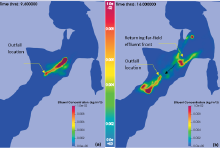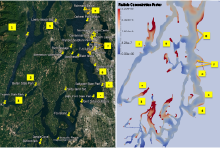SSM Marine Pollution
Overview
Salish Sea supports a diverse ecosystem and harbors numerous marine species which are vulnerable to the adverse impacts from marine pollution from anthropogenic causes and population growth. In addition to the existential threat to marine species, marine pollution in Salish Sea has a great impact on the region's economy where fisheries and other forms of aquaculture is a multi-billion-dollar fishing industry. Hence, the local agencies which are responsible for maintaining the water quality standard of the Salish Sea have a keen interest on developing modeling tools which are useful to their mission. PNNL has developed such modeling tools with the collaboration of US EPA and Department of Ecology that work with the Salish Sea Model to conduct exposure assessment studies and help design solutions to mitigate the problem of marine pollution in the Salish Sea.
Projects

Developing FVCOM-plume Model: A Three Dimensional Outfall Plume Model for Dynamic Tidal Environments - 3D outfall plume simulation under tidal conditions and captures the near-field plume characteristics, while simulating far-field transport using detailed hydrodynamic information

Simulating Microplastics: Transport in the Salish Sea - transport characteristics of microplastics in the Salish Sea were analyzed using a particle tracking model and the hydrodynamic solutions produced by the Salish Sea Model (SSM). This study explores microplastics accumulation features and characteristics in the Salish Sea controlled primarily by bathymetry, shoreline complexity, and tidal circulation.
Salish Sea hosts nearly a hundred of waste water outfalls which discharge a considerable amount of nutrients and other pollutants in addition to the loads delivered by numerous stormwater and watershed runoff streams. It is the responsibility of agencies such as U.S. EPA and Washington State Department of Ecology (Ecology) to assess the impact of these point sources and regulate them to maintain the water quality at acceptable levels for the designated uses. FVCOM-ICM model developed at PNNL in collaboration with Ecology is being used to assess the nutrient loading to mitigate the marine pollution caused by the eutrophication, toxic algal blooms and etc. In addition to this benchmark water quality model, we recently also developed a modeling tool (FVCOM-plume) to conduct detailed assessments of outfall discharges under tidal conditions using the same unstructured grid framework in the Salish Sea model. FVCOM-plume is capable of simulating both near-field and far-field plume features and accommodate cumulative effects of multiple outfalls with multi-port diffusers under tidal conditions in a complex topography. PNNL is developing Lagrangian Particle Tracking techniques for exposure assessment efforts. This component of the Salish Sea model has been recently used in a study to investigate the basic fate and transport of microplastics in Salish Sea with the growing concern of microplastic induced marine pollution.